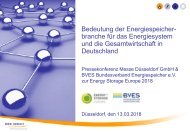Renewable Energy – Solutions for application in the communal energy infrastructure
This brochure contains a selection of successful renewable energy solutions suitable for a range of applications for local and national municipalities and economies. The main energy end-use sectors and the current state of the energy transition are briefly explained to provide readers with an understanding of the transformation of the greater energy system. The renewable energy technology options are explained, including their relevance and applications for municipalities. Finally, a selection of exemplary projects that have been successfully implemented in Europe, the Russian Federation and Central Asia, are included to demonstrate real applications and use-cases for renewable solutions. Renewable energies are cheap, clean and versatile.
This brochure contains a selection of successful renewable energy solutions suitable for a range of applications for local and national municipalities and economies. The main energy end-use sectors and the current state of the energy transition are briefly explained to provide readers with an understanding of the transformation of the greater energy system. The renewable energy technology options are explained, including their relevance and applications for municipalities. Finally, a selection of exemplary projects that have been successfully implemented in Europe, the Russian Federation and Central Asia, are included to demonstrate real applications and use-cases for renewable solutions. Renewable energies are cheap, clean and versatile.
You also want an ePaper? Increase the reach of your titles
YUMPU automatically turns print PDFs into web optimized ePapers that Google loves.
22 | BIOENERGY<br />
Biogas <strong>–</strong> stored solar <strong>energy</strong> to gas<br />
Biogas is produced by ferment<strong>in</strong>g <strong>energy</strong> crops, slurry, biological waste or similar materials <strong>in</strong> a fermenter. It<br />
primarily consists of methane and can be used <strong>in</strong> a similarly flexible way as natural gas <strong>–</strong> <strong>for</strong> cook<strong>in</strong>g, heat<strong>in</strong>g,<br />
electricity generation and even as a fuel.<br />
Biogas is produced by fermentation from organic<br />
substances, from slurry to grass and biogenic waste. If<br />
local waste materials are used <strong>for</strong> its production, such<br />
as from agriculture or <strong>the</strong> food and cater<strong>in</strong>g <strong>in</strong>dustries,<br />
<strong>the</strong> added value <strong>in</strong>creases at a local level. Biogas consists<br />
ma<strong>in</strong>ly of methane, i.e. <strong>the</strong> substance that is also<br />
<strong>the</strong> primary component of natural gas, and is similarly<br />
versatile.<br />
This means that conventional gas-fired power plants,<br />
natural gas-driven cars, heavy goods vehicles or even<br />
ships can also be run on biogas.<br />
One particular advantage of biogas <strong>in</strong> <strong>the</strong> course of <strong>the</strong><br />
<strong>energy</strong> transition is its storability. It can effectively<br />
help balance <strong>the</strong> fluctuat<strong>in</strong>g generation of w<strong>in</strong>d and<br />
solar power <strong>in</strong> <strong>the</strong> system.<br />
Often, <strong>the</strong> biogas is used to run local cogeneration<br />
plants <strong>–</strong> standardised m<strong>in</strong>i power plants that supply<br />
electricity and heat at <strong>the</strong> same time. This ensures a<br />
particularly efficient use of <strong>the</strong> <strong>energy</strong>. Biogas can also<br />
be used <strong>for</strong> cook<strong>in</strong>g, heat<strong>in</strong>g and even as a fuel source<br />
<strong>for</strong> specially adapted vehicles. What’s more, it is possible<br />
to process biogas <strong>in</strong>to pure methane. This can <strong>the</strong>n<br />
be used <strong>in</strong> exactly <strong>the</strong> same way as natural gas and can<br />
also be fed <strong>in</strong>to <strong>the</strong> natural gas grid and extracted aga<strong>in</strong><br />
elsewhere.<br />
For farms, <strong>the</strong> technology offers yet ano<strong>the</strong>r advantage:<br />
The fermentation residues from <strong>the</strong> fermenter possess<br />
even better properties as fertiliser when compared to<br />
<strong>the</strong> start<strong>in</strong>g material.








